How Do Type B Leakage Protection Devices Provide Protection?
 A wave of new electrical systems applications, including electrical vehicle (EV) charging stations and photovoltaic system protection and other devices are presenting new earth leakage protection challenges. ETEK Eletric offers a complete range of RCD, from add-on devices for circuit breakers to complete residual current circuit breakers (RCCB).
A wave of new electrical systems applications, including electrical vehicle (EV) charging stations and photovoltaic system protection and other devices are presenting new earth leakage protection challenges. ETEK Eletric offers a complete range of RCD, from add-on devices for circuit breakers to complete residual current circuit breakers (RCCB).
What is earth leakage protection?
Earth leakage protection is a technology which works by monitoring the current flowing through the conductors.
If the current becomes unbalanced between active and neutral, it indicates some current is flowing elsewhere and that a short circuit and current leakage is present. The device shuts off the power very quickly to prevent the danger of an electric shock.
What is an RCD or RCCB?
An RCD or RCCB is a Residual Current Device or Residual Current Circuit Breaker – an earth leakage protection device.
This is the device which monitors the flow of current and detects any residual (i.e. an imbalance).
How does an RCD or RCCB work?
RCD or RCCB compares the values of live and neutral wires.
In case there is a fault, the current that flows from the neutral wire will reduce. The difference is the residual current, and when it spots the residual current, it triggers the RCCB and, hence, trips off the circuit.
How to ensure the reliability of RCCB?
The reliability of the RCCB is ensured by the test circuit included in the residual current device.
The current will start to flow through the test circuit once the test button is pushed. This will create an imbalance on the neutral wire present in the device that will make the RCCB trip, and you must disconnect the supply.
Therefore, you must check the reliability of the RCCB.
What are the different ratings of RCCB?
Classification can be carried out according to the residual current sensitivity, and different residual current sensitivity tripping levels have certain uses: 10mA, 30mA, 100mA, 300mA, 500mA, 1000mA
The recommended tripping level for maximum shock protection is 30mA.
A tripping level of 100 mA will still give a degree of shock protection if it’s not possible to use a 30mA device.
While a 300mA should never be used for shock protection, its purpose is to provide fire and equipment protection.
What are the advantages of RCCB?
1. Protect the false or any leakage current.
2. Automatically disconnect the circuit when the sensitivity limit is exceeded.
3. Provides the possibility of dual termination for both cable as well as bus bar connections.
4. Protection against any fluctuation in the voltage as it has a filtering device that will help guard against the transient voltage levels.
Limitations of RCCB:
RCCB will not guarantee to operate if load generates the standard waveforms. It is so because it is designed to operate only on the supply of standard waveforms. It might be possible that there is some unwanted tripping of RCCB. It happens as there are specific changes in the electrical load.
RCCB will not protect against current overload. It is designed in a way to protect only the live current and the neutral current. Hence, a current overload will not be detected.
RCCB also does not protect against the line neutral shocks that occur. It happens because the current in them is balanced.
RCCB does not protect the overheating that might try conductors that are not properly screwed.
What is an RCBO?
RCD/RCCB do not provide any protection from short circuits or other over-current situations. In order to provide this protection, most installations utilizing RCD would also include a circuit breaker in the series.
RCBO are compact devices that offer both earth leakage and over current/short circuit protection.
What are the three tripping curve types of RCBO?
Tripping Curve B - MCB with Trip Curve B trips instantly at a rate of three to five times its rated current. They are suitable for cable protection, residential and light commercial uses.
Tripping Curve C - MCB with Trip Curve C trips instantly at a rate of five to ten times its rated current. Typically used for high inductive loads. Suitable for domestic and residential applications.
Tripping Curve D - MCB with Trip Curve D trips instantly at a rate of ten to twenty times its current rate. Used for extremely high inductive loads such as motor with high inrush current.
How many types of RCD are there?
The International lEC Standard defines four types of RCD for AC applications.
These types, which address the various kinds of residual current waveforms, are known as type AC, type A, type F (this paper does not explain) and type B. All these devices are intended to be used within AC supply systems.
-
Type AC residual current devices

Type AC RCD detect residual sinusoidal alternating currents. Type AC RCD are suitable for general use and cover most of the applications in practice. -
Type A residual current devices

In addition to the detection characteristics of type AC RCD, Type A RCD detects pulsating DC residual current. Such waveforms can be caused by diode or thyristor rectifier circuit in electronic loads. Type A RCD are specifically intended to be used for single phase class 1 electronic loads. -
Type B residual current devices

Type B RCD can detect sinusoidal AC, pulsating DC, composite of multi-frequency as well as smooth DC residual currents. In addition, tripping conditions are defined with different frequencies from 50Hz to 1kHz. In an AC electrical distribution network, a pure DC residual current can be mainly generated from three-phase rectifying circuits, but also from some specific single-phase rectifiers.
Type B RCD are intended to be used for loads with three-phase rectifier, such as variable speed drives, PV system, EV charging station and medical equipment.
Different types of RCD

How do Type B Residual Current Devices Work?
Type B RCD are usually designed with two residual current detection systems.
1. ‘Fluxgate’ technology to enable the RCD to detect smooth DC current.
2. Uses a technology similar to Type AC and Type A RCD, which is voltage independent. This means that, even if line voltage is lost, a residual current fault can still be detected and people are still protected.
Typical applications for Type B RCD
- 3-phase EV chargers
Type B RCD are ideal for use with 3-phase EV chargers, as EV manufacturers state that DC current leakage can occur while charging.
Though a 6mA detection device inside the charger can provide protection, a Type B RCD ensures better continuity of service and protection because it will detect DC current and its tripping value is much higher than 6mA DC. It will also detect earth leakage current at frequencies higher than 50/60Hz.
- 3 phase PV systems
For 3 phase PV systems, a Type B RCD is also recommended to protect against electrocution, due to DC/AC converters being used.
- 3-phase drives
3-phase drives can create earth leakage currents at various frequencies, as well as DC. This can include applications such as a crane powered from a mobile panelboard, or an elevator. These require a Type B RCD for protection, with the trip current rating selected based on the specific application.
ETEK Electric Type B RCCB:
The EKL6-100B Type B RCCB has obtained the CE TUV and UKCA certificate. It can ensure higher protection levels with maximum operational continuity under all working conditions. For this reason, it is considered universal devices because they provide protection against all the tripping waveforms listed in Standards EN 62423.
This Type B RCCB can ensure maximum safety in many applications, such as EV Charging Station, Crane and Elevator, PV and Wind power plants, etc.
Conclusion
There are multiple reasons to use a type B residual of the current circuit breaker. Based on the installation location and the surrounding conditions, the residual current circuit breaker will require test voltage and will also alert us in real-time. It is also easy to install and has quick on and off features. It will reduce the risk of electric shock to you and your family. It can also protect your home against the risk of fire caused by faulty wiring or appliances.
You can use type B leakage protection device to directly replace the RCD protection device in existing consumer units if desired. ETEK Electric will ensure the most suitable and safest device.






.jpg)





